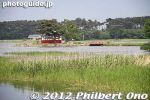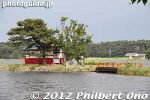 Image search results - "reeds" Image search results - "reeds" |

Seta River
|
|

Seta River and reeds
|
|

This part was flooded in 2001, and it is now teeming with reeds, fish, and other wildlife which entered this wetland naturally over the years. A local NPO conducts tours and hands-on activities for kids and adults.
|
|

Reed beds abound in the southern portion of the biotope. Invasive species are also very minimal compared with Lake Biwa.
|
|

Reeds are vital for fish and birds. They can spawn or nest here and hide from predators. Reeds also function as a water purifier. Lake Biwa has lost much of its reed beds due to development.
|
|

Chonoki River cuts through the biotope. Looking upstream. 丁野木川
|
|

Chonoki River looking downstream toward Lake Biwa. This river divides the Hayasaki biotope into the northern and southern areas.
|
|

On the northern area, is this flooded area. Less reeds than in the southern area. This area is more suited for migratory birds like swans which come here each winter. This place is popular with bird watchers and wildlife photographers in winter.
|
|

Northern area of Hayasaki biotope. Hayasaki naiko has an area of 17 hectares. About one-fourth of this has been flooded on an experimental basis. The flooded paddies are leased to Shiga Prefecture which pays rent to the land owners.
|
|

On the right of the flooded section are rice paddies not yet flooded. Shiga wants to eventually purchase all the reclaimed land and flood the entire area to restore Hayasaki Naiko.
|
|

Rice paddy and reed bed. Special thanks to Makino Atsushi (Lake Biwa Museum) and Kurahashi Yoshihiro (Hayasaki Biotope Networking) for the tour of Hayasaki biotope.
|
|

Rice paddy and reed bed. Restoring Hayasaki Naiko may take decades. For tours (May-Nov.) of Hayasaki biotope, call in Japanese: 0749-72-2262 (Hayasaki Biotope Networking).
|
|
|
|

Adogawa River
|
|
|
|
|
|

Kamo River empties into Lake Biwa.
|
|

Reeds barely grow here.
|
|

Tataranuma is the only place in Gunma where migrating swans come to winter. An abundance of reeds makes it ideal for wildlife.
|
|

A shrine on a small island called Ukishima is dedicated to Benzaiten. The pleasant lakeside park also has lots of cherry blossoms and picnic space.
|
|

Ukishima island in Tataranuma Park.
|
|
|
|
|
|





















